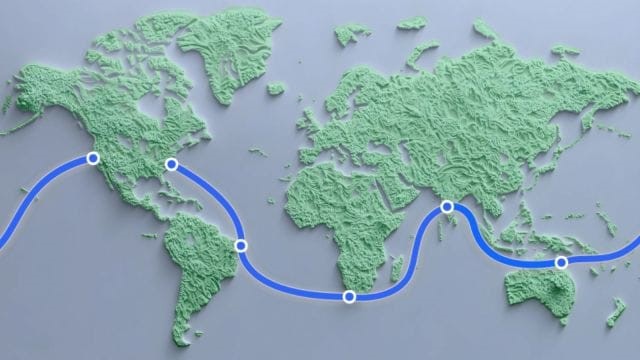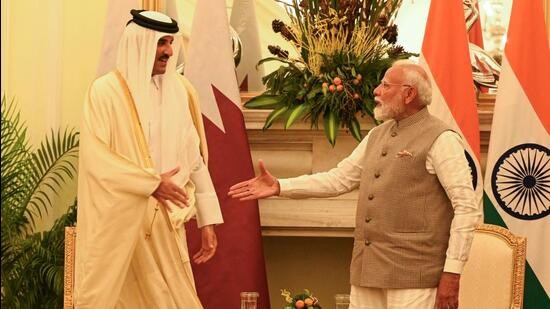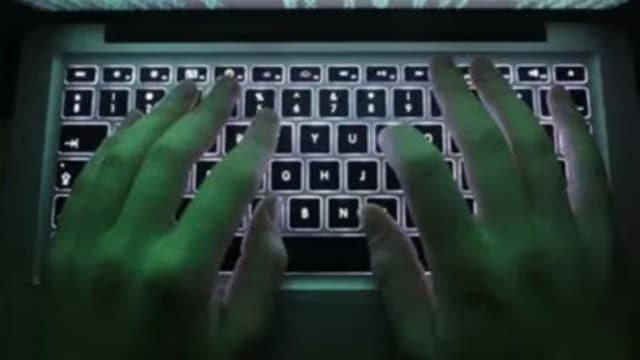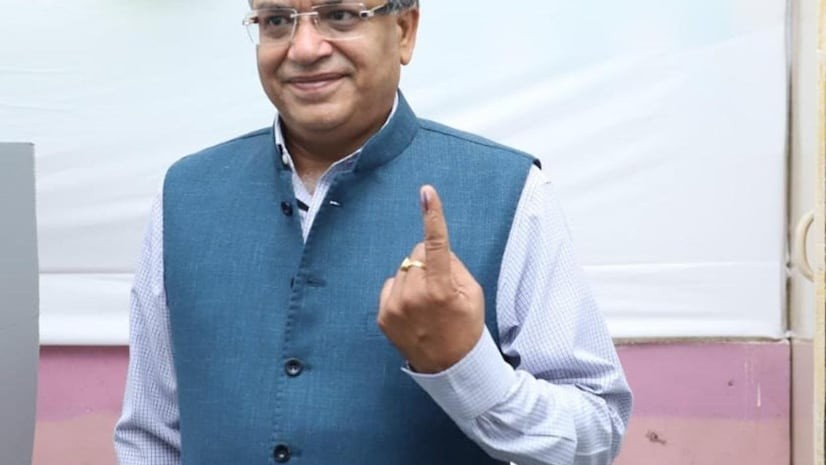Meta’s Project Waterworth

- 22 Feb 2025
In News:
Meta has launched Project Waterworth, its most ambitious subsea cable initiative to date, aimed at enhancing global digital connectivity. The project involves the deployment of AI-driven subsea cable infrastructure, with India being a key beneficiary.
Key Features:
- Massive Scale:A multi-billion dollar, multi-year global initiative, the project will lay over 50,000 km of undersea cables, connecting five continents, including India, the USA, Brazil, South Africa, and others.
- AI Integration:The project leverages advanced machine learning models to predict and mitigate network disruptions, ensuring greater resilience and reliability of global internet infrastructure.
- Deep Water Deployment:The cable will operate at depths reaching 7,000 meters, using enhanced burial techniques in high-risk areas to prevent damage from ship anchors and other maritime hazards.
- Digital Backbone:Subsea cables like those in Project Waterworth currently carry over 95% of global internet traffic, forming the backbone of international digital communication, video streaming, e-commerce, and cloud-based AI services.
Strategic Relevance for India:
- India’s Digital Push:The project supports India’s growing digital economy by ensuring faster, more reliable internet connectivity and fostering digital inclusion and innovation.
- AI and Infrastructure Synergy:With AI-driven maintenance and deployment, the initiative complements India's vision of becoming a global hub for AI, data centers, and digital services.
- Economic and Strategic Benefits:Enhanced connectivity is expected to boost economic cooperation, cross-border trade, and participation in global digital platforms.
India–Qatar Strategic Partnership

- 22 Feb 2025
In News:
In February 2025, His Highness Sheikh Tamim bin Hamad Al-Thani, Amir of Qatar, paid a State Visit to India, during which India and Qatar elevated their bilateral relations to a Strategic Partnership.
Major Outcomes of the 2025 Summit
- Strategic Partnership Agreement:Formalized multifaceted cooperation across sectors—trade, investment, energy, security, technology, and people-to-people ties.
- Trade and Economic Engagement:
- Target set to double bilateral trade to $30 billion by 2030 (from $14 billion in FY 2023–24).
- Joint Commission on Trade and Commerce established to monitor economic ties.
- Qatar Investment Authority (QIA) pledged $10 billion in Indian infrastructure, green energy, and startups.
- Revised Double Taxation Avoidance Agreement signed.
- Energy Cooperation:
- A landmark 20-year LNG supply deal (2028–2048) between QatarEnergy and Petronet LNG.
- Collaboration in renewable energy including green hydrogen, solar energy, and AI-based efficiency solutions.
- Investment and Digital Integration:
- QIA to open an office in India; Qatar National Bank to set up presence in GIFT City.
- India’s UPI system operationalized in Qatar's POS infrastructure; nationwide rollout planned.
- Technology and Innovation:
- Cooperation in AI, semiconductors, IoT, robotics and digital governance.
- Indian startups to participate in Web Summits in Doha (2024–25).
People-to-People and Cultural Ties
- Over 830,000 Indians reside in Qatar, forming the largest expatriate community.
- MoUs signed on youth, sports, education, archives, and cultural cooperation.
- Agreement to celebrate India-Qatar Year of Culture, Friendship and Sports.
Security and Counter-Terrorism
- Strong condemnation of terrorism in all forms, including cross-border terrorism.
- Commitment to enhanced cooperation in intelligence sharing, cybercrime, anti-money laundering, and countering transnational crimes.
- Emphasis on regular meetings of the Joint Committee on Security and Law Enforcement.
Labour and Health Cooperation
- Agreement to hold regular Joint Working Group on Labour and Employment to address expatriate welfare and mobility.
- Collaboration in the health sector, including pharma exports, device registration, and pandemic response mechanisms.
Geopolitical and Multilateral Cooperation
- Exchange of views on Middle East stability, UN reforms, and India-GCC engagement.
- Appreciation for Qatar’s Chairmanship of the India-GCC Strategic Dialogue (Sept 2024).
- Agreement on UN Security Council reform and advancing SDG goals through multilateralism.
Challenges Ahead
- Trade Imbalance: Imports of LNG/LPG ($12B) far exceed exports (<$2B).
- Labour Rights Concerns: Working conditions of Indian laborers in Qatar remain under scrutiny.
- Legal and Judicial Issues: Over 600 Indians in Qatari jails; need for agreement on transfer of sentenced persons.
- Geopolitical Complexities: Qatar’s involvement in West Asian diplomacy presents nuanced challenges.
- Naval Veterans Case: Pending resolution affects diplomatic sentiment.
Way Forward
- Boost Indian exports in pharmaceuticals, IT, engineering goods.
- Expedite India-Qatar Bilateral Investment Treaty (BIT) to streamline FDI.
- Expand collaboration in green hydrogen, carbon capture, and energy diversification.
- Strengthen ministerial-level engagements, labor welfare frameworks, and regional security dialogue.
NAKSHA Programme
- 22 Feb 2025
In News:
The Union Ministry of Rural Development has launched a pilot project titled NAKSHA(National Geospatial Knowledge-based Land Survey of Urban Habitations) in 152 Urban Local Bodies (ULBs) across 26 States and 3 Union Territories, with the inauguration taking place in Raisen, Madhya Pradesh.
Key Highlights:
Objective of NAKSHA
The NAKSHA initiative aims to:
- Create and update urban land records for accurate, reliable documentation of property ownership.
- Empower citizens by improving ease of access to land records.
- Facilitate urban planning and reduce land-related disputes.
- Promote transparency, efficiency, and sustainable development through an IT-based system.
Key Features
- Technical Partner: The Survey of India will carry out aerial surveys and provide orthorectified imagery via third-party vendors.
- Implementation Partners:
- Madhya Pradesh State Electronics Development Corporation (MPSEDC) will develop a web-based GIS platform.
- National Informatics Centre Services Inc. (NICSI) will provide data storage facilities.
- Execution at State Level: States and UTs will conduct field surveys and ground truthing, leading to the final publication of urban and semi-urban land records.
Kaveri 2.0 Cyberattack

- 22 Feb 2025
In News:
In January–February 2025, Karnataka's property registration portal, Kaveri 2.0, faced major disruptions due to a Distributed Denial of Service (DDoS) attack, severely affecting property registrations and revenue generation. The portal, launched in 2023, is a key component of the state's e-governance infrastructure.
What is a DDoS Attack?
A Distributed Denial of Service (DDoS) attack aims to disrupt a server, service, or network by flooding it with excessive traffic, rendering it inaccessible to legitimate users.
How it works:
- Botnet Formation: Hackers compromise multiple devices using malware, turning them into bots.
- Traffic Overload: These bots generate huge volumes of fake traffic directed at the target system.
- Service Disruption: The targeted service slows down or crashes, affecting user access.
Types of DDoS Attacks:
- Bandwidth Saturation – Exhausting the target's internet capacity.
- Protocol Exploitation – Abusing vulnerabilities in network protocols.
- Application Targeting – Crashing specific applications or services.
Kaveri 2.0 Case: AI-Based DDoS Attack
- The Stamps and Registration Department (SRD) of Karnataka confirmed that the portal was targeted using AI tools that generated over 20 lakh fake search queries per day—far beyond its capacity of 2.5 lakh.
- These queries mainly targeted services like Encumbrance Certificate (EC) searches, causing widespread slowdown and outages.
- On February 1, only 556 property registrations occurred, compared to the usual 8,000–9,000 daily, with revenue dipping to ?15.18 crore from an average of over ?62 crore.
- After mitigation, services were restored by February 7, returning to normal levels of 7,225 registrations and ?62.59 crore in revenue.
Impact of DDoS Attacks on Public Services
- Operational Disruption: Essential citizen services are halted, creating public inconvenience.
- Financial Loss: Delayed transactions and reduced revenue, as seen in the Kaveri 2.0 case.
- Reputational Damage: Public trust in digital governance platforms may erode.
- Cybersecurity Risks: DDoS attacks can mask more sophisticated intrusions.
Preventive Measures
- Traffic Filtering: Using AI tools to detect and block abnormal traffic.
- Rate Limiting: Restricting the number of queries per user/IP.
- Bot Detection: Implementing CAPTCHAs and behavior analysis.
- Robust Authentication: Enhancing security for administrative access.
- Incident Response Teams: Dedicated cybersecurity units to respond to threats promptly.
Chief Election Commissioner Appointment

- 22 Feb 2025
In News:
Gyanesh Kumar has been appointed as the new Chief Election Commissioner (CEC) of India, becoming the first to be selected under the new legislative framework — The Chief Election Commissioner and Other Election Commissioners Act, 2023. He succeeds Rajiv Kumar. Simultaneously, Dr. Vivek Joshi, former Haryana Chief Secretary, was appointed as an Election Commissioner.
Constitutional Basis
- Article 324 of the Indian Constitution provides for the Election Commission of India (ECI), consisting of the CEC and such other Election Commissioners as the President may determine.
- It vests the superintendence, direction, and control of elections in the ECI for conducting elections to Parliament, State Legislatures, and for the offices of the President and Vice President.
Earlier Appointment Process
- Governed by convention and the Election Commission (Conditions of Service of Election Commissioners and Transaction of Business) Act, 1991.
- The CEC was appointed by the President on the advice of the Prime Minister, with no formal selection mechanism defined in law.
New Appointment Process (2023 Act)
The Chief Election Commissioner and Other Election Commissioners Act, 2023 introduced a formal selection process:
- Selection Committee:
- Prime Minister (Chairperson)
- A Union Cabinet Minister (nominated by the PM)
- Leader of Opposition (or largest opposition party leader) in the Lok Sabha
- Search Committee:
- Headed by the Cabinet Secretary, this body shortlists eligible candidates.
- Eligibility Criteria:
- Must be a person of integrity
- Must have experience in election management
- Must be or have been a Secretary (or equivalent) to the Government of India
Service Conditions (As per 2023 Act)
- Salary & Status: Equivalent to that of a Cabinet Secretary (earlier: Supreme Court judge).
- Tenure: 6 years or till the age of 65, whichever is earlier.
- Reappointment: Not permitted.
Removal Process
- CEC: Can only be removed in the same manner and on the same grounds as a Supreme Court judge (i.e., by Parliament through impeachment).
- Election Commissioners: Can only be removed on the recommendation of the CEC.
Functions & Powers of CEC
- Conducts elections to the Lok Sabha, Rajya Sabha, State Assemblies, and offices of the President & Vice President.
- Regulates political parties and election funding.
- Enforces the Model Code of Conduct (MCC).
- Maintains and updates electoral rolls and supervises the voter registration process.
- Has the authority to disqualify candidates and cancel elections in case of serious irregularities.
- Advises the President and Governors on election-related matters.
Judicial Context & Controversy
- In the Anoop Baranwal vs Union of India case, the Supreme Court ruled that the independence of the ECI must be preserved and directed that a law be enacted to define the appointment process.
- Until such legislation was passed, the Court had prescribed a selection committee comprising:
- The Prime Minister
- The Leader of Opposition in the Lok Sabha
- The Chief Justice of India (CJI)
- However, the 2023 Act excluded the CJI, replacing the judiciary with another executive appointee, raising concerns about executive dominance.
- Multiple petitions challenging the constitutionality of the Act are pending before the Supreme Court.
